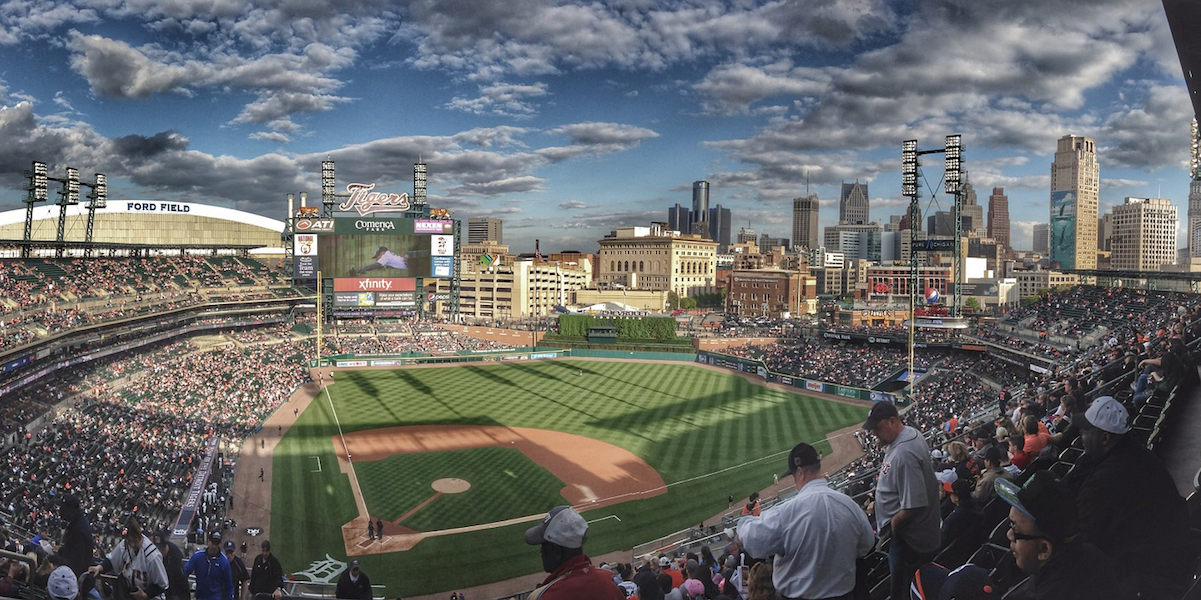MAGAZINE
ルーターマガジン
jupyter notebookで野球データをビジュアライズ part 2

日本シリーズ開幕!!
こんにちは!
ルーターエンジニアのohkabeです。
日本シリーズが開幕しました。
前回に引き続き野球のデータをjupyter notebookでビジュアライズします。
下準備
以下のモジュールを使用しますのでインポートしておきましょう。
import pandas as pd
import matplotlib.pyplot as plt
%matplotlib inline
import seaborn as sns今回のデータは以下のリンクからお借りしました。
コードの書き方も参考にしています。
https://github.com/Shinichi-Nakagawa/pitchpx-example-pitchfx
MIT LicenseCopyright (c) 2016 Shinichi nakagawa
https://github.com/Shinichi-Nakagawa/pitchpx-example-pitchfx/blob/master/LICENSE
ダルビッシュ投手の配球をmatplotlibで可視化
今回はダルビッシュ選手の実際の投球データを使用し、matplotlibで散布図にします。
まずはデータフレームを読み込み、概要を見てみましょう。
df_src = pd.read_csv("https://raw.githubusercontent.com/Shinichi-Nakagawa/pitchpx-example-pitchfx/master/datasets/yu_darvish_201608170_pitch.csv")
df = df_src[['px', 'pz', 'pitch_type', 'start_speed', 'pa_ball_ct','pa_strike_ct']]
# 球速をマイルからキロに直す
df["start_speed"] = df["start_speed"] * 1.61
df.head()| px | pz | pitch_type | start_speed | pa_ball_ct | pa_strike_ct | |
|---|---|---|---|---|---|---|
| 0 | 0.764 | 0.693 | FF | 146.188 | 0 | 0 |
| 1 | -0.111 | 3.403 | FF | 144.739 | 1 | 0 |
| 2 | 0.547 | 2.286 | FF | 146.993 | 0 | 0 |
| 3 | -2.332 | 3.216 | FT | 145.222 | 0 | 1 |
| 4 | 0.252 | 3.430 | SL | 126.224 | 1 | 1 |
カラムは左から順に、
- 投球の水平位置
- 投球の垂直位置
- 球種
- 球速
- ボールカウント
- ストライクカウント
です。
球種の略記は以下のように対応しています。
PITCH_TYPES = {'CU': 'Curveball','FC': 'Cut Fastball','FF': 'four-seam Fastball','FS': 'Split-finger Fastball','FT': 'two-seam Fastball','SL': 'Slider',}
ではここで、どの球種をよく投げるのか見てみましょう。
pandasのvalue_counts()関数を使うと、値ごとに回数を数えてくれます。
df["pitch_type"].value_counts()
/* FF 39
/* FT 21
/* SL 14
/* FC 13
/* CU 9
/* FS 3
/* Name: pitch_type, dtype: int64
もっとも多いのがFF(フォーシーム)で、39回投げています。
value_counts(normalize=True)とすると割合で出力してくれます。
df["pitch_type"].value_counts(normalize=True)
/* FF 0.393939
/* FT 0.212121
/* SL 0.141414
/* FC 0.131313
/* CU 0.090909
/* FS 0.030303
/* Name: pitch_type, dtype: float64
次に球速の密度分布を見てみましょう。
ax = sns.distplot(df["start_speed"])

155キロから110キロの落差があるようです。
散布図の作成
def get_marker(pitch_type):if pitch_type == 'FF':return 'o'elif pitch_type == 'FT':return '3'elif pitch_type == 'FC':return '4'elif pitch_type == 'FS':return '1'elif pitch_type == 'CU':return '$◢$'elif pitch_type == 'SL':return '>'return 'H'
fig = plt.figure(figsize=(13,9))
ax = fig.add_subplot(1, 1, 1)
ax.set_xlabel('px')
ax.set_xlim((-3.0, 3.0))
ax.set_ylabel('pz')
ax.set_ylim((0.0, 5.0))
ax.grid(True)
# ストライクゾーン
ax.vlines(-0.8, ymin=1.5, ymax=3.32)
ax.vlines(0.8, ymin=1.5, ymax=3.32)
ax.hlines(1.5, xmin=-0.8, xmax=0.8)
ax.hlines(3.32, xmin=-0.8, xmax=0.8)
for key, grp in df.groupby('pitch_type'):
c = grp['start_speed']
marker = get_marker(key)
label = PITCH_TYPES[key]
ax = plt.scatter(grp['px'],grp['pz'],c=c,cmap="jet",marker=marker,label=label, alpha=0.7)
plt.clim(df['start_speed'].min(),df['start_speed'].max())
plt.colorbar()
plt.legend(bbox_to_anchor=(1, 1))
plt.show()

この図は球種、速度、コースをキャッチャー視点でグラフ化したものです。
色が球速、マーカーが球種を表しています。
真ん中の四角がストライクゾーンです。
ぱっと見、右上には投げないというのが見えますが、これは大きな特徴ではないでしょうか。
しかし、このままではあまりにも乱雑なプロットなので、よく分かりません。
次は球種別にデータを整理して、グラフを分解して見ます。
球種でグラフを分解
pandasのgroupbyメソッドで球種に対してグループ分けを行い、描画します。
fig, axes = plt.subplots(nrows=2, ncols=3, figsize=(16, 8))
for (key, grp),ax in zip(df.groupby('pitch_type'),axes.flat):
ax.title.set_text(PITCH_TYPES[key])
ax.set_xlim((-3.0, 3.0))
ax.set_ylim((0.0, 5.0))
ax.grid(True)
ax.vlines(-0.8, ymin=1.5, ymax=3.32)
ax.vlines(0.8, ymin=1.5, ymax=3.32)
ax.hlines(1.5, xmin=-0.8, xmax=0.8)
ax.hlines(3.32, xmin=-0.8, xmax=0.8)
c = grp['start_speed']
marker = get_marker(key)
im = ax.scatter(grp['px'],grp['pz'],c=c,cmap="jet",marker=marker, alpha=1,
vmin=df['start_speed'].min(), vmax=df['start_speed'].max())
fig.subplots_adjust(right=0.8)
cbar_ax = fig.add_axes([0.83, 0.15, 0.02, 0.7])
im.set_clim(vmin=df['start_speed'].min(), vmax=df['start_speed'].max())
cbar = fig.colorbar(im, cax=cbar_ax)
どうでしょうか。
だいぶスッキリして見えます。
こうして見ると、フォーシーム(直球)とツーシーム(左に曲がる)とカットボール(右に曲がる)がほぼ同じ速度です。
打者から見ると、直球と左右の変化球で、見分けがつかない三択になっているのでしょう。
カーブは遅いですね。
配給の特徴としては
- フォーシームは左上から右下の対角線上
- ツーシームは左下
- スライダーは真ん中に寄る
という癖が有るように見えますね。
ボールカウントでグラフを分解
さらにボールカウントの情報を与えて配給を分解して見ましょう。
# ストライク * ボールの組み合わせで12個のグラフを作りたい
fig, axes = plt.subplots(nrows=4, ncols=3, figsize=(32, 32))
count = 0
for ax in axes.flat:
# 列がストライク、行がボールのカウントとなるように配置
strike = count % 3
ball = count // 3
tmp = df[(df['pa_ball_ct'] == ball) & (df['pa_strike_ct'] == strike)]
count +=1
ax.title.set_text("Strike{}-Ball{}".format(strike, ball))
ax.set_xlim((-3.0, 3.0))
ax.set_ylim((0.0, 5.0))
ax.grid(True)
ax.vlines(-0.8, ymin=1.5, ymax=3.32)
ax.vlines(0.8, ymin=1.5, ymax=3.32)
ax.hlines(1.5, xmin=-0.8, xmax=0.8)
ax.hlines(3.32, xmin=-0.8, xmax=0.8)
for key, grp in tmp.groupby('pitch_type'):
marker = get_marker(key)
c = grp['start_speed']
label = PITCH_TYPES[key]
im = ax.scatter(grp['px'],grp['pz'],c=c,cmap="jet",marker=marker,label=label,
alpha=1, vmin=df['start_speed'].min(), vmax=df['start_speed'].max())
ax.legend(bbox_to_anchor=(1, 1))
fig.subplots_adjust(right=0.8)
cbar_ax = fig.add_axes([0.83, 0.15, 0.02, 0.7])
im.set_clim(vmin=df['start_speed'].min(), vmax=df['start_speed'].max())
cbar = fig.colorbar(im, cax=cbar_ax)
画像を開いて、拡大して見て見ると
- カーブは初球に投げる
- 2-0では右下に投げる
- ボールカウントが増えると直球率が高くなる
- 意外にもカウント2-3では外しに来る
- 追い込んだとき or 追い込まれた時には配球が右下に集まっている
ように見えますね。
終わりに
弊社ではデータスクレイピングだけでなく、pythonを用いた機械学習やデータビジュアライズなども承っております。
最近流行りのデータサイエンスでソリューションを生み出しましょう。
データコンサルティングのご案内
CONTACT
お問い合わせ・ご依頼はこちらから
